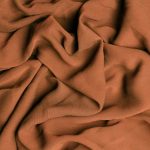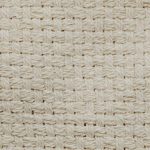Chino fabric is mainly made from cotton twill, giving you a durable yet soft material perfect for daily wear. You’ll find it primarily uses long-staple cotton varieties like Pima or Egyptian cotton for added smoothness, although upland cotton is common too. The twill weave creates a diagonal pattern, enhancing strength and wrinkle resistance while keeping it breathable. Sometimes, chinos blend in synthetic fibers to boost stretch and durability. If you want to understand its full story and how it compares to other fabrics, keep exploring.
Table of Contents
Key Takeaways
- Chino fabric is primarily made from cotton twill, providing a smooth, soft, and durable texture.
- The cotton used is often long-staple varieties like Pima or Egyptian for enhanced softness and strength.
- Some chinos blend cotton with synthetic fibers to improve stretch, durability, and shape retention.
- The twill weave creates a distinct diagonal pattern, contributing to the fabric’s durability and flexibility.
- 100% cotton chinos offer excellent breathability, lightweight comfort, and a smooth feel suitable for all-day wear.
History and Origin of Chino Fabric
Although many people associate chino fabric with modern casual wear, it actually has a rich history dating back to the 19th century. You’ll find that chino fabric was originally developed for military uniforms, especially for soldiers in the British and American armies. Its durable, tightly woven structure made it perfect for tough conditions and long marches.
When you wear chinos today, you’re connecting with that practical heritage. Over time, the fabric shifted from military use to civilian fashion, gaining popularity because of its comfort and versatility.
You might be surprised to learn that the name “chino” comes from the Spanish word for “Chinese,” reflecting the fabric’s early production in China before spreading worldwide. This sturdy fabric still keeps its functional roots while fitting seamlessly into everyday style.
Primary Fiber Used in Chino Fabric
You’ll find that cotton is the main fiber used in chino fabric, giving it softness and breathability.
Sometimes, manufacturers blend cotton with synthetic fibers to add stretch or durability.
Understanding these variations helps you choose the right chino for your needs.
Cotton’s Role in Chino
Cotton forms the foundation of chino fabric, giving it the softness and breathability you expect in comfortable pants. When you wear chinos, the cotton fibers work to keep you cool by allowing air to circulate, which is perfect for warmer days.
You’ll also notice how cotton’s natural absorbency helps wick away moisture, so you stay dry and comfortable throughout the day. Beyond comfort, cotton’s durability means your chinos can handle regular wear and washing without losing shape or texture.
Plus, cotton’s smooth surface allows for a clean, crisp appearance—ideal if you want chinos that look polished yet feel relaxed. Overall, cotton’s natural qualities make it the perfect primary fiber that balances comfort, durability, and style in chino fabric.
Blends and Variations
While cotton remains the primary fiber in chino fabric, manufacturers often blend it with other materials to enhance performance and comfort. These blends improve durability, stretch, and moisture-wicking properties. For example, adding polyester increases strength and wrinkle resistance, while elastane offers flexibility for better movement.
Here’s a quick breakdown:
| Fiber | Purpose | Benefit |
|---|---|---|
| Cotton | Base fiber | Softness, breathability |
| Polyester | Synthetic blend | Durability, wrinkle resistance |
| Elastane | Stretch fiber | Flexibility, shape retention |
| Linen | Natural blend (less common) | Breathability, texture |
Cotton Varieties Commonly Used in Chino
Different types of cotton fibers shape the quality and feel of chino fabric.
You’ll often find chinos made from long-staple cotton varieties like Pima or Egyptian cotton. These fibers are prized for their strength and smoothness, giving the fabric a soft yet durable texture.
Upland cotton, the most common type, is also used in chinos, offering good quality at a more affordable price point.
When you choose chinos made from long-staple cotton, you’ll notice they resist pilling and maintain their appearance longer.
Some manufacturers blend different cotton types to balance cost and performance, but pure long-staple cotton chinos tend to feel more luxurious.
Understanding these cotton varieties helps you pick chinos that match your comfort and durability needs.
The Role of Twill Weave in Chino Fabric
You’ll notice that chino fabric’s strength comes from its twill weave structure, which creates a distinct diagonal pattern.
This weave not only boosts durability but also gives the fabric a smooth yet textured feel.
Understanding this will help you appreciate why chinos hold up so well over time.
Twill Weave Structure
Because twill weave creates a distinctive diagonal pattern, it plays an essential role in defining chino fabric’s texture and durability.
When you look closer, the twill weave structure consists of interlacing threads in a specific pattern, giving chino its unique feel.
Here’s what you should know about this weave structure:
- Threads pass over one or more threads, then under two or more, creating diagonal ribs.
- This pattern repeats consistently, allowing flexibility and a smooth surface.
- The weave’s angle determines the strength and stretch of the fabric.
- Twill weave helps the fabric resist wrinkles and shows fewer stains.
Understanding this structure helps you appreciate why chino fabric feels soft yet sturdy, perfect for daily wear.
Durability and Texture
Although chino fabric looks simple, its twill weave plays a major role in how durable and textured it feels. When you wear chinos, you benefit from the diagonal rib pattern created by the twill weave, which strengthens the fabric and resists wear and tear.
This structure makes chino fabric tougher than plain weaves, so it holds up well against daily use and frequent washing. You’ll also notice the subtle texture that adds visual interest and a soft hand feel, making chinos comfortable yet sturdy.
The twill weave helps the fabric drape nicely without losing shape, so your chinos maintain a crisp appearance. In short, the twill weave gives chino fabric its signature blend of resilience and smooth texture, perfect for both casual and semi-formal wear.
Blended Fabrics in Chino Production
Many chinos today incorporate blended fabrics to balance durability, comfort, and style.
You’ll find manufacturers mixing cotton with synthetic fibers to enhance performance without sacrificing that classic look.
Here’s what blending can offer you:
- Improved Stretch: Adding elastane or spandex gives chinos more flexibility, perfect if you move a lot.
- Wrinkle Resistance: Polyester blends help keep your chinos looking crisp throughout the day.
- Moisture Wicking: Some blends pull sweat away from your skin, keeping you cooler.
- Enhanced Durability: Synthetic fibers strengthen the fabric, extending the life of your chinos.
Characteristics of 100% Cotton Chino
While blended fabrics offer added benefits, 100% cotton chinos remain a favorite for their natural feel and breathability. You’ll notice they’re soft against your skin, making them comfortable for all-day wear. These chinos also wick moisture effectively, keeping you cool in warmer weather. Plus, their classic look works well in casual and semi-formal settings.
Here’s a quick overview of their key traits:
| Characteristic | Description |
|---|---|
| Breathability | Excellent air circulation |
| Texture | Soft, smooth, natural feel |
| Comfort | Lightweight and non-restrictive |
| Appearance | Matte finish with subtle sheen |
| Care | Requires gentle washing to maintain softness |
Choosing 100% cotton chinos means prioritizing comfort and natural fabric benefits without synthetic blends.
Durability Factors in Chino Material
When you choose chinos, understanding what affects their durability helps you get the most wear out of them. Several key factors play a role in how long your chinos will last.
- Fabric Weight: Heavier cotton twill fabrics resist wear and tear better than lighter ones.
- Weave Tightness: A tighter weave means stronger fibers, reducing the chance of snags or holes.
- Fiber Quality: Long-staple cotton fibers create more durable fabric compared to short-staple varieties.
- Construction Details: Reinforced stitching and quality thread improve the garment’s overall strength and lifespan.
Breathability and Comfort of Chino Fabric
Durability keeps your chinos lasting through countless wears, but comfort and breathability determine how pleasant they feel throughout the day.
Chino fabric, primarily made from cotton twill, naturally allows air to flow, helping to keep you cool even when temperatures rise. The tight weave balances sturdiness with breathability, so you won’t feel suffocated or overly warm.
When you wear chinos, the soft cotton fibers wick moisture away, reducing sweat buildup and enhancing comfort. Plus, many chinos include a slight stretch, allowing freedom of movement without restriction.
Whether you’re sitting in a meeting or walking on a sunny afternoon, the breathable nature of chino fabric guarantees you stay comfortable and fresh all day long.
Differences Between Chino and Denim Fabric
Although both chino and denim fabrics are staples in casual wardrobes, they serve different purposes and offer distinct styles.
When choosing between them, keep these key differences in mind:
- Material Composition: Chino fabric uses lightweight cotton twill, while denim is heavier with a rugged cotton weave.
- Texture and Feel: Chinos feel smooth and soft, perfect for warmer weather, whereas denim is coarse and sturdy.
- Color and Finish: Chino fabric often comes in solid, muted tones; denim features indigo dye with visible weave patterns.
- Use and Style: Chinos suit semi-formal looks and offer versatility, while denim leans casual and durable, great for everyday wear.
Knowing these differences helps you pick the right fabric for your outfit and occasion.
Environmental Impact of Chino Fabric Production
Since chino fabric primarily relies on cotton, its production has a significant environmental footprint that you should consider. Growing cotton demands large amounts of water and often involves pesticides, which can harm local ecosystems.
When you buy chino garments, you indirectly support these practices unless the cotton is sourced sustainably. Additionally, the dyeing and finishing processes in chino fabric manufacturing use chemicals and energy, contributing to pollution and carbon emissions.
You can reduce this impact by choosing chinos made from organic or recycled cotton or from manufacturers committed to eco-friendly processes. Being aware of these factors helps you make informed choices and encourages brands to adopt greener production methods, minimizing the environmental toll of your chino fabric wardrobe.
Innovations in Chino Fabric Materials
Addressing the environmental challenges of traditional chino fabrics has sparked a wave of innovation in the industry.
You’ll find that manufacturers now focus on sustainability without sacrificing quality or comfort.
Here are four key innovations transforming chino fabric materials:
- Organic Cotton: Grown without harmful pesticides, it reduces environmental impact and improves fabric softness.
- Recycled Fibers: Incorporating recycled polyester or cotton cuts down waste and conserves resources.
- Tencel Blends: Derived from sustainably harvested wood pulp, Tencel adds breathability and moisture-wicking properties.
- Waterless Dyeing: This technology minimizes water usage and harmful chemicals during fabric coloring.
Frequently Asked Questions
How Should I Care for Chino Fabric Clothing?
Think of your chino fabric like a loyal companion—treat it gently. You should wash it in cold water, avoid bleach, and tumble dry low or air dry to keep its shape and color vibrant for the long haul.
Can Chino Fabric Be Used for Upholstery?
You can use chino fabric for upholstery, but it’s not the most durable option. It’s better suited for clothing. If you do use it, expect some wear and tear quicker than heavy-duty upholstery fabrics.
Are Chinos Suitable for All Seasons?
You can wear chinos year-round since they’re lightweight and breathable for warmer months but also pair well with layers in cooler weather. Just choose thicker or lined options for extra warmth during winter seasons.
What Colors Are Most Common for Chino Fabric?
Did you know over 70% of chinos sold are in classic colors? You’ll find beige, navy, olive, and khaki most common, making them versatile pieces you can easily mix and match with your wardrobe.
How Do Chinos Fit Compared to Other Pants?
You’ll find chinos fit slimmer than traditional jeans but more relaxed than dress pants. They hug your waist and taper slightly, offering a comfortable, versatile silhouette that works well for both casual and semi-formal occasions.
- A Crafter’s Guide to Working With Nonwoven Fabrics - July 12, 2025
- Nonwoven Fabrics: A Sustainable Alternative? - July 12, 2025
- How GSM Affects the Performance of Nonwoven Fabric - July 12, 2025







